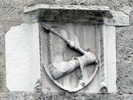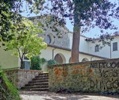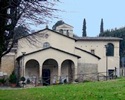

Important Monuments in Terni
Duomo (re-modelled in 1653)
ca. 830 - Bishop Liutardus of Spoleto verified the rediscovery of the relics of St Anastasius, probably during the reconstruction of the church
12th century - new church of Santa Maria Interamnes built on the site;
1218 - Pope Honorius III restored the independent diocese of Terni; Prior Ranierio of Santa Maria Interamnes became Bishop of Terni and his church became the Duomo of the new diocese
1653 - Bishop Cardinal Francesco Angelo Rapaccioli rebuilt the church and re-consecrated it in honour of Santa Maria Assunta
San Valentino (1605-30)
8th century - Benedictines built a monastery on the site, when the area was part of the diocese of Narni
1255 - church passed to the new diocese of Terni, but was subsequently abandoned
1605 - relics of St Valentine found on the site; construction of the present church began soon after, and a community of Discalced Carmelites moved to the adjoining convent
1860 - Carmelites were forced to leave the convent; returned in 1906
San Francesco (1265-88)
13th century - new church built and decorated after papal indulgences in 1259 and 1288
ca. 1450 - Bartolomeo di Tommaso painted scenes from the Last Judgement in the Cappella dei Paradisi
1866 - Franciscan community suppressed; church subsequently abandoned
1927-2002 - complex used by Salesians of St John Bosco
Church recently re-opened after extensive restoration
San Pietro (1287)
14th century - Dormition of the Virgin, autograph work of the so-called Maestro della Dormitio di Terni, painted in chapel on left
1703 - church badly damaged in earthquake
1866 - Augustinian community suppressed
1943 - church damaged in bombing of the Second World War
Church still in use: convent houses a school and the ambulance service
Other Monuments in Terni
Cascata delle Marmore
One of the highest artificial waterfalls in Europe
274 BC - Manius Curius Dentatus opened an artificial channel to divert the Velino River over a precipice and into the Nera, to prevent flooding of plain of Rieti
1422 - Pope Gregory XII commissioned a new canal, but problems with flooding persisted
16th century - further papal initiatives
1787 - waterfall took on current appearance
19th century - started to be used for industrial purposes
1929 - adapted to form the hydroelectric complex
Cassero
(ca. 1372)
[Link to Cassero]
1358 - “cassarum pontis Sancti Antonii” first documented; Cardinal Gil Albornoz had probably built it as part of the papal reconquest of Umbria
1442 - demolished after a short but eventful history
City Walls, Gates and Bridges
Page describes:
-
✴the Roman and medieval walls of Terni;
-
✴the five medieval gates:
-
•Porta Romana;
-
•Porta Sant’ Angelo, illustrated above;
-
•Porta San Giovanni;
-
•Porta del Sesto; and
-
•Porta Spoletina; and
-
✴the three bridges over the Nera:
-
•Ponte di Sant’ Antonio;
-
•Ponte Romano; and
-
•Ponte del Sesto
Confraternita di San Nicandro
Important confraternity, dedicated to the needs of the poor, the sick, and pilgrims
1291 - received church of San Nicandro; also used San Cleto and built adjacent Ospedale dei Pellegrini
ca. 1400 - San Cleto Triptych (illustrated above) painted for second church
1860 - suppressed
Franciscan Nunneries
in Terni
Page describes:
-
✴San Paolo di Galleto (ca. 1228-1458);
-
✴Santa Caterina (documented in 14th century);
-
✴San Procolo (1508); and
-
✴SS Annunziata (1542)
16th century - altarpiece illustrated above painted for San Procolo
1862 - nuns from the last two of these nunneries moved to Santa Maria dell’ Oro (below)
1990 - after other moves, nuns acquired Monastero di SS Annunziata, Colleluna
Palazzo Comunale (1862-78)
1295 - original Palazzo del Podestà built here
1516 - Palazzo Apostolico built next to it
1564 - failure of anti-papal Banderari revolt; both palaces adapted as seat of papal government
1703 - destroyed in earthquake
1862-78 - rebuilt by Benedetto Faustini after unification
1972 - municipal government left this palace for Palazzo Spada (below)
1994 -restored
Now houses Biblioteca Comunale
Palazzo di Sanità
(19th century)
Site of:
-
✴Oratorio di San Gregorio;
-
✴SS Siro e Bartolomeo; and
-
✴Oratorio di Santa Lucia, which belonged to Confraternita del Suffragio
1548 - Marcantonio Rustici built church of Santa Lucia here for the confraternity
1620 - Jesuits acquired church and built an adjacent convent and college
1860 - suppressed; complex subsequently had various functions
1980s - housed the municipal health services and became known as the Palazzo di Sanità
2000 - adapted as offices of the Provincial Government; traces of an Iron Age settlement and of a Roman domus found at this time
Palazzo Vescovile and Palazzo del Seminario (ca. 1650-1740)
1218 - Palazzo Vescovile built to left of Duomo, on site of Roman amphitheatre (below)
1653 - Bishop Francesco Angelo Rapaccioli commissioned an extension of Palazzo Vescovile; he also established the seminary and commissioned Palazzo del Seminario, to the right of the Duomo
Palazzo del Seminario now houses the Museo Diocesano.
Palazzo Mazzancolli
(15th century)
Giovanni Mazzancolli built this palace
18th century - fell into ruins when family became extinct
1873 - bought by Congregazione di Carità, who restored it
1879 - Monte di Pietà moved here
1933 - Fascist party bought palace
1945 - passed to Commune
1970 - became seat of city archives
Sant' Alò
(11th century)
1252-4 - occupied by Augustinians, who built an adjoining convent
ca. 1400 - probably passed to Poor Clares
18th century - passed to Knights of Malta
1904 - Roman archeological fragments found near the Duomo embedded in walls
1959 - after a long period of secular use, acquired by the diocese, re-consecrated and restored; now used by an Orthodox community from Romania.
Santa Maria del Carmine (1602-1783)
16th century - Confraternita del Carmine commissioned an oratory on this site to house a venerated fresco (early 15th century) known as the Madonna del Carmine, which was on the walls of the amphitheatre (above)
1602- confraternity commissioned present church
It has been recently restored, and is now used as an auditorium
Santa Maria del Cassero (1546-84)
1546 - Compagnia del SS Sacramento founded this church on the site of the demolished Cassero (above) to house a venerated image (16th century) of the Madonna and Child
1841 - church demolished; venerated image moved to a tabernacle (illustrated here) in what is now Palazzo Rosci (above)
Santa Maria delle Grazie (1472-82)
1472 - second church and convent of Observant Franciscans in Terni commissioned here
ca. 1550 - rebuilt; original portal and the facade survive
17th century - three chapels built on left
1703 - apse destroyed in earthquake
1779 - apse rebuilt
1798-9 - friars moved temporarily to San Valentino (above); French authorities used the convent as a military hospital
1865 - suppressed; art transferred to Pinacoteca; convent used as an old people’s home (now ruined)
Church occasionally open
Santa Maria del Monumento
(15th century)
15th century - church built on site of a Roman funerary monument to house a venerated image of the Madonna della Misericordia (the surviving part of which was stolen in 1984)
1474 - church passed to a community of Jeronymites, who restored and extended it
ca. 1800 - Jeronymites left Terni
1839 - Commune acquired the site and established the adjacent cemetery
What is now the cemetery church preserves a number of interesting frescoes
Santa Maria dell’ Oro (1434-41)
1434 - first church and convent of Observant Franciscans in Terni commissioned here
1860 - community suppressed
1860-95 - nuns from San Procolo and SS Annunziata (above) moved here
1910 - church became a parish church; convent used as a school until 1927, when it was adapted as an old people’s home
Santa Teresa
(1618)
[Link to
One of the first nunneries in Italy belonging to the female order of reformed Carmelites
1642- nuns built a new church, which was dedicated to St Joseph
1810 - nuns were forced to leave; complex used as a barracks
1943 - complex was damaged in the bombardment of the Second Wold War and subsequently demolished
San Tommaso
(1753)
Site of an ancient parish church, which was used for political meetings in the early days of the Commune
1703 - church destroyed in earthquake and subsequently rebuilt
ca. 1924 - deconsecrated and its parish role transferred to Sant’ Antonio da Padova (above)
Now houses the Mostra Permanente di Paleontologia (Paleontological Collection)
Tre Monumenti
(3rd century AD)
1568 - Pope Pius V apparently ordered demolition of three monuments; according to tradition, they commemorated:
-
✴the historian Gaius Cornelius Tacitus (died ca. 117 AD);
-
✴the Emperor Tacitus (275-6 AD) and
-
✴the Emperor Florianus (276 AD), his half-brother and successor
1907 - bases of three Roman funerary monuments found in what became Piazza Tre Monumenti (illustrated here); assumed (unreliably) to have belonged to the monuments above



































